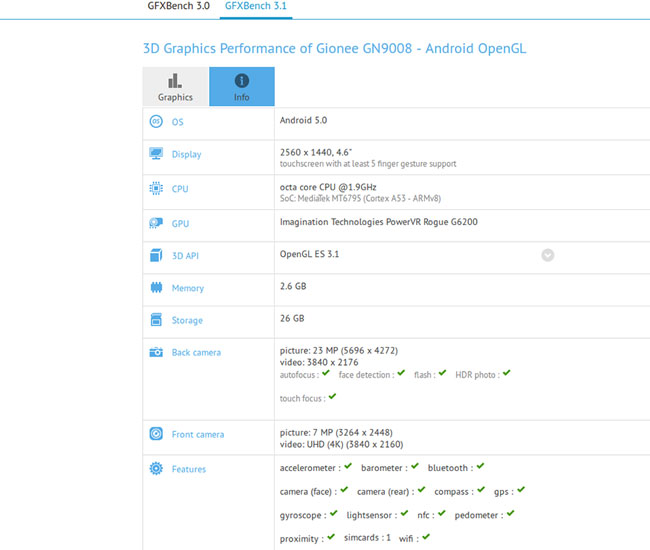



 (3 ratings)
(3 ratings)
A while ago, the Chinese mobile phone manufacturer: Gionee has appeared in multiple tidings due to rumors regarding its upcoming smartphone: Elife E8. And now, a catalog of corporation's yet another handset popped up over GFXBench benchmark site, which is clearly showing that mobile phone will carry a Model Number: GN9008.
As yet, cyberspace has become crowded with a raft of speculations regarding this unofficial smartphone. Notably, a report of GSMArena says handset will be branded as Elife E8, whereas Phonearena has envisaged that gadget is a successor of Elife S7 GN-9006, so that it has been codenamed as GN-9008 and will roll out in marketplace with a moniker: Elife S8. Well, we are not sure about the name of device because it is quite puzzling and onerous due to a number of hearsay.
Taking a glance at released brochure via GFXBench, the most eye-popping part of this unannounced mobile is its 4.6-inch display with QHD resolution of 2560x14400p that translates to pixel density of 639ppi. Here, pixel density of handheld is even higher and more vibrant than Samsung Galaxy S6 and Galaxy S6 edge, which confer pixel density of 577ppi.

Besides display, the one more highlighted part of phone will be incorporation of octa-core MediaTek MT6795 processor clocked at 1.9GHz alongside PowerVR Rogue G6200 GPU. The device will run Android 5.0 Lollipop and it will comprise 3GB RAM accompanied by 32GB of inbuilt storage. The one more USP of forthcoming handset will be its 23-megapixel autofocus rear camera with LED flash.
However, listing shows 7MP front snapper that is not a standard resolution for smartphone camera, so we can expect 8-megapixel selfie sensor in Gionee GN9008. To remind you, president of company: William Lu had stated that firm will bring Elife E8 globally in June, so if GN9008 is actually the successor of Elife E7, then we will have to wait till June to get remaining specs of this hotly-anticipated scion of Gionee.
Image Source: GFXBench